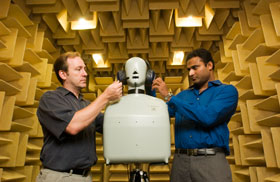  |
| HOME | THIS ISSUE | CALENDAR | GRANTS | BACK ISSUES | < BACK | NEXT > |
Researchers creating devices to improve critical communicationsby Jane Shaskan - October 17, 2005 |
||||
|
Airplane pilots, military personnel, and others who work in noisy environments may benefit from research conducted at the Health Center’s new acoustics laboratory. The project involves studying the effectiveness of hearing protectors equipped with noise reduction systems either mounted in a headset or worn in the ear canal. “We are working on hearing protector technology that can combine noise reduction systems to prevent hearing loss, while at the same time enhancing speech and the ability to hear warning alarms,” says Anthony Brammer of the Biodynamics Laboratory, chief investigator on the study. “The devices are designed to maintain speech intelligibility and will be especially useful in circumstances where clear communications are critical,” he says. People working in environments with high noise levels have long complained that hearing protection devices interfere with their ability to communicate and to hear warning alarms, says Brammer. He recently gave a presentation on the effects of noise on speech and communications to a NATO task force investigating noise reduction systems for military applications. Completed last year, the acoustics laboratory was funded by NASA to conduct voice communications research. The $2 million facility consists of an anechoic chamber (one free from echoes and reverberations), and its counterpart, a reverberation room that minimizes sound absorption. In the anechoic chamber, sound is absorbed by hundreds of custom-designed fiberglass wedges covering the walls, floor, and ceiling. The reverberation room uses standard building materials and is constructed with very rigid walls to increase sound reflections. As part of the project, a headset is being tested to determine the extent of the device’s ability to reduce outside noise while improving speech intelligibility, explains co-investigator Donald Peterson, director of the Biodynamics Lab.
“Reducing environmental noise, and maintaining or improving speech intelligibility in headsets and earplugs, requires an understanding of the limitations imposed by physical acoustics, signal processing, and electronics, as well as the physiological and psychological mechanisms influencing the understanding of speech,” he says. “We expect to increase the performance characteristics of hearing protection and communication devices with technologies we develop in this lab.” The military can benefit from such devices, he says. Military research has shown a significant increase in the success rates of complicated missions when the speech intelligibility was improved between military personnel. The current communication earplugs used by the Army are acceptable, Peterson says, but there is room for improvement. “By incorporating this noise reduction control system within an earplug, we think communications can be much better,” he says, “and be compatible with U.S. Army safety requirements.” |
| ADVANCE HOME UCONN HOME |

